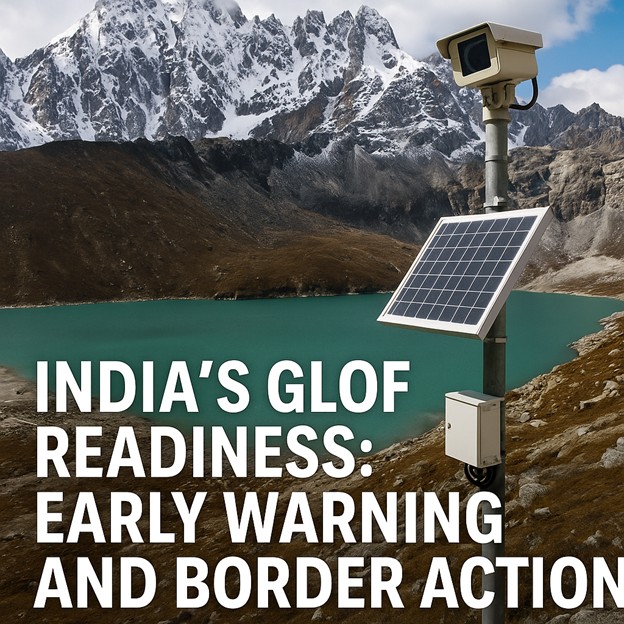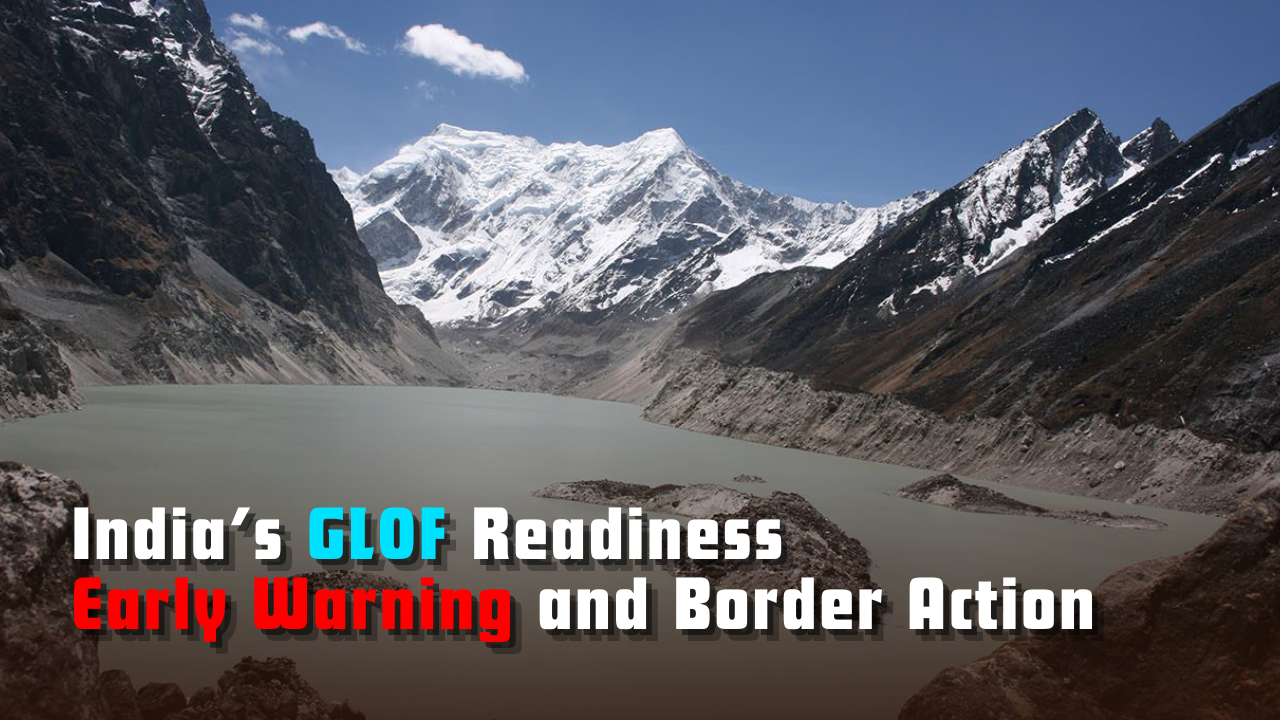India’s GLOF Readiness: Early Warning and Border Action
Explore India’s response to Himalayan GLOF threats—glacial lake trends, early warning gaps, and the need for cross-border cooperation.

Introduction: GLOF
The Himalayan region, known for its towering peaks and breathtaking glaciers, is facing an unprecedented environmental challenge: the melting of glaciers due to global warming. One of the most dangerous consequences of this phenomenon is the occurrence of Glacial Lake Outburst Floods (GLOFs), which occur when water, trapped behind glaciers or unstable moraine dams, is suddenly released. These floods can cause widespread destruction, particularly in the downstream areas of Nepal and India, where communities and critical infrastructure are at significant risk. GLOFs have already wreaked havoc in Nepal, and the growing number of glacial lakes in the Indian Himalayas raises serious concerns about the region’s preparedness.
This essay, inspired by Safi Ahsan Rizvi’s article “How is India Preparing Against GLOF Events?” (The Hindu, July 28, 2025), examines the trends in glacial lake development, the risks posed by GLOFs, and the necessary steps India must take to enhance its readiness through improved monitoring, early warning systems, and cross-border cooperation. It argues that a comprehensive, multi-layered approach is crucial for mitigating the escalating GLOF risks in India’s Himalayan regions.
Trends in Glacial Lake Development
The ongoing warming of the Earth’s climate has accelerated the melting of glaciers in the Himalayas. As glaciers retreat, they leave behind glacial lakes, often dammed by unstable moraine or ice. In recent decades, the number and size of these lakes have significantly increased, both in Nepal and India. Historical data and satellite imagery have confirmed the enlargement of many glacial lakes, with some reaching sizes large enough to release millions of cubic metres of water in the event of an outburst. These lakes, particularly those formed in high-altitude, remote areas, represent a growing hazard that threatens communities, infrastructure, and ecosystems across the region. For example, the formation of larger supraglacial and moraine-dammed lakes in both India and Nepal signals the urgent need for continuous monitoring and risk assessment.
Catastrophic Outbursts: Lessons from Nepal
Nepal has been the site of multiple GLOF events, which have provided stark lessons in the devastating potential of such floods. One of the most significant events was the 1985 Dig Tsho GLOF, which caused massive damage to the infrastructure in the Khumbu region, disrupting the local economy and communities. More recently, the rapid expansion of glacial lakes such as Imja Tsho has prompted national and international efforts to assess and mitigate these risks. Nepal has faced recurring challenges from GLOFs, with more than two dozen incidents documented in recent decades. These floods have not only caused loss of life but also resulted in long-term damage to hydropower plants, roads, bridges, and agricultural land. The destruction of the Tsho Rolpa lake, which had been identified as a major threat, was mitigated by lowering its water levels through artificial drainage. However, such measures are not always feasible, especially when the lakes are located in hard-to-reach areas or when the resources required to implement them are unavailable. Nepal’s experience has highlighted the importance of effective monitoring, early warning systems, and cross-border collaboration.
Emerging Risks in India
India, with its vast Himalayan range, is not immune to the threat posed by GLOFs. The Indian Himalayan Region (IHR), which stretches across several states from Jammu and Kashmir to Arunachal Pradesh, is home to thousands of glaciers and an increasing number of glacial lakes. These lakes are often remote and unmonitored, making it difficult to assess the risks they pose. Recent events, such as the Kedarnath disaster in 2013 and the South Lhonak GLOF in Sikkim in 2023, serve as poignant reminders of the vulnerability of India’s Himalayan region. Both incidents were linked to the rapid melting of glaciers and the subsequent release of water from glacial lakes. The Kedarnath disaster, in particular, caused widespread destruction, killing thousands and displacing many more. Similarly, the South Lhonak GLOF caused significant damage to the $2 billion Chungthang dam, which not only interrupted power supply but also exacerbated flooding downstream. Such events underscore the importance of robust preparedness strategies, especially in areas where glacial lakes are poorly mapped and assessed.

The Core Problem: GLOF Risk and the Early Warning Deficit
One of the biggest challenges in managing GLOF risks in the region is the lack of adequate early warning systems. Despite growing awareness, both Nepal and India face significant gaps in monitoring and forecasting GLOF events. Nepal has made strides in setting up monitoring systems for some of its glacial lakes, such as the Tsho Rolpa lake, but these systems are often limited to specific high-risk lakes and are not sufficiently scaled up. Many glacial lakes, particularly those in remote areas, remain unmonitored, leaving downstream communities vulnerable to sudden flooding.
In India, the situation is even more precarious. Vast stretches of the Indian Himalayan Region are difficult to access, and as a result, the majority of glacial lakes remain unmapped or inadequately assessed. Even those lakes that are monitored often lack real-time data and early warning systems. While satellite imagery can provide valuable insights into the size and growth of these lakes, it is a post-facto measure that does not offer the immediate alerts needed for emergency response. This significant gap in early warning and monitoring infrastructure puts lives and livelihoods at risk, particularly in the densely populated valleys below many glacial lakes.
Transboundary Hazards and the Collaboration Gap
Glacial lake outburst floods do not respect national borders, as many of the Himalayan rivers that flow from Nepal and India originate in China’s Tibet Autonomous Region. GLOFs originating in China have, in the past, caused significant downstream damage in Nepal and India, yet there has been little cooperation between these countries on risk monitoring and early warning systems. The lack of data-sharing agreements, the political sensitivities between these nations, and the absence of coordinated disaster management frameworks make it difficult to effectively address the transboundary nature of GLOF risks. Without collaborative efforts, it is unlikely that effective early warning systems can be established in the region. A more integrated approach to monitoring and risk management, involving all three countries, is essential to reduce the likelihood of a GLOF disaster.
The Need for Transboundary Cooperation and Multi-Layered Solutions
One of the most crucial steps in mitigating the risks of GLOFs is fostering greater transboundary cooperation between Nepal, India, and China. This cooperation must involve the sharing of hydrological data, the development of joint monitoring systems, and coordinated efforts to assess the risks of glacial lakes across borders. Establishing standardized monitoring protocols and data-sharing mechanisms is critical for improving early warning capabilities and ensuring that the downstream regions in all three countries are adequately prepared for potential disasters. Bilateral and multilateral agreements on these issues would help strengthen the region’s disaster preparedness and response mechanisms, and prevent further loss of life and property.
Additionally, the use of advanced technology can greatly enhance monitoring capabilities. Satellite-based remote sensing, Synthetic Aperture Radar (SAR) interferometry, and automated weather and hydrological stations can help monitor the condition of glacial lakes in real-time and provide valuable data for predicting potential outburst floods. Drone technology can also be employed to conduct more detailed inspections of high-risk lakes, enabling quicker responses to emerging threats. By integrating such technologies into a comprehensive monitoring system, India can significantly improve its ability to detect and mitigate GLOF risks.
Scaling Mitigation in the Difficult Himalayan Terrain
The logistical challenges of monitoring and mitigating GLOF risks in the Himalayan region are considerable. High altitudes, remote locations, and harsh weather conditions make it difficult to reach many glacial lakes. Despite these challenges, targeted interventions, such as lowering the water levels of at-risk lakes or reinforcing moraine dams, can significantly reduce the likelihood of a catastrophic outburst flood. However, it is unrealistic to apply these measures to every potentially hazardous lake, given the scale of the region. Instead, a prioritised approach should be adopted, focusing resources on the lakes that pose the greatest risk to human life and infrastructure. This strategy should be informed by regular assessments of lake conditions, updated hazard maps, and the latest scientific data.
Counterview: The Limits of Technology and Diplomacy
It is important to acknowledge that there are significant challenges to implementing the proposed solutions. The scale and inaccessibility of the Himalayan region mean that it may not be feasible to deploy early warning systems and monitoring technology in every high-risk area. Additionally, political and diplomatic sensitivities between India, Nepal, and China could hinder the establishment of efficient data-sharing mechanisms and coordinated disaster response efforts. These challenges, however, should not be seen as reasons for inaction but as a call for a phased, strategic, and persistent approach to risk reduction.
Recommendations for a Comprehensive GLOF Risk Mitigation Strategy
- Transboundary Cooperation: Establish coordinated frameworks for risk assessment and early warning between India, Nepal, and China, with standardized monitoring protocols and data-sharing mechanisms.
- Enhanced National Monitoring: Invest in satellite monitoring, SAR, and automation of hydrometeorological data collection to improve real-time monitoring capabilities.
- Community-Based Risk Reduction: Train and equip local residents for lake monitoring and emergency response, ensuring that hazard maps and evacuation protocols are widely communicated.
- Scaling Mitigation Efforts: Prioritise interventions for the most dangerous lakes, including artificial drainage or reinforcement of moraine dams.
- Institutional Strengthening: Enhance the capacity of the NDMA and other relevant bodies to coordinate risk assessments and disaster response efforts.
Conclusion
India is at a crossroads in its battle against the escalating risks posed by Glacial Lake Outburst Floods. While the challenges of monitoring, early warning, and cross-border collaboration are significant, the cost of inaction is far greater. The lessons learned from Nepal’s experience, combined with India’s own risks and vulnerabilities, demonstrate the need for a comprehensive, multi-layered approach to mitigate the impact of GLOFs. By investing in advanced technologies, fostering international cooperation, and engaging local communities in risk reduction efforts, India can strengthen its preparedness and ensure the safety and resilience of its Himalayan regions in the face of climate change. The future of the region depends on decisive, collaborative action now.
Subscribe to our Youtube Channel for more Valuable Content – TheStudyias
Download the App to Subscribe to our Courses – Thestudyias
The Source’s Authority and Ownership of the Article is Claimed By THE STUDY IAS BY MANIKANT SINGH



